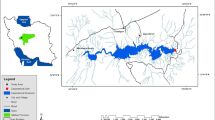Abstract
In this research, the simulation of Urmia Lake water level fluctuation by means of two models was applied. For this, Support Vector Machines (SVM), and Neural Wavelet Network (NWN) models that conjugated both the wavelet function and ANN, developed for simulating the Urmia Lake water level fluctuation. The yearly data of rainfall, temperature and discharge to the Urmia Lake and water level fluctuation were used. Urmia Lake is the biggest and the hyper saline lake in Iran. The outcome of the SVM based models are compared with the NWN. The results of SVM model performs better than NWN and offered a practical solution to the problem of water level fluctuation predictions. Analysis results showed that the optimal situation occurred with use of precipitation, temperature and discharge for all station and water level fluctuations at the lag time of one year (RMSEs) of 0.23, 0.41 m obtained by SVM, NWN, respectively, and SSEs of 0.43, 1.33 and R 2 of 0.97, 0 obtained by SVM, NWN, respectively. The results of SVM model show better accuracy in comparison with the NWN model.
Similar content being viewed by others
References
Altunkaynak, A., Forecasting surface water level fluctuations of Lake Van by artificial neural networks, Water Resources Management, 2007, vol. 21,Is. 2, no. 3, pp. 99–408.
Asefa, T., Kemblowski, M., McKee, M., and Khalil, A., Multi-time scale stream flow predictions: the support vector machines approach, Journal of Hydrology, 2005, vol. 318,Iss. 1–4, no. 1, March 2006, pp. 7–16.
Chang, F.-J. and Chen, Y.-C., Estuary water-stage forecasting by using radial basis function neural network, Journal of Hydrology, 2003, vol. 270, pp. 158–166.
Chen, S.-T. and Shan, P., Pruning of support vector networks on flood forecasting, Journal of Hydrology, 2007, vol. 347,Iss. 1–2, pp. 67–78.
Chen, S.T. and Yu, P.S., Real-time probabilistic forecasting of flood stages, Journal of Hydrology, 2007, vol. 340Iss. 1–2, pp. 63–77.
Chen, Y., et al., A local wavelet neural network, Proc. of the 5th World on Intelligent Control and Aut., P.R. China: Hangzhou, 2004, pp. 1954–1957.
Čimen, M. and Kisi, O., Comparison of two different data-driven techniques in modeling lake level fluctuations in Turkey, Journal of Hydrology, 2009, vol. 378,Iss. 34, pp. 253–262.
Cortes, C. and Vapnik, V., Support-vector networks, Machine Learning, 1995, vol. 20, http://www.springerlink.com/content/k238jx04hm87j80g
Dawson, C.W. and Wilby, R.L., Hydrological modeling using artificial neural networks, Prog. Phys. Georgr., 2001, vol. 25, no. 1, pp. 80–108.
De Vos, N.J. and Rientjes, T.H.M., Constaints of artificial neural network for rainfall-runoff modeling: tradeoffs in hydrological state representation model evaluation, Hydrol. Earth Syst. Sci., 2005, vol. 9, pp. 111–126.
Hsu, N.-S. and Wei, C.-C., A multipurpose reservoir real-time operation model for flood control during typhoon invasion, Journal of Hydrology, 2007, vol. 336, pp. 282–293.
Lekutai, G., Adaptive SELF Tuning Neuro Wavelet Network Controllers, PhD Thesis, Virginia Polytechnic Institute and State Univ. The Electrical Eng. Dept., 1997.
Lin, G.F., Chen, G.-R., Huang, P.-Y., and Chou, Y.-C., Support vector machine-based models for hourly reservoir inflow forecasting during typhoon-warning periods, Journal of Hydrology, 2009, vol. 372,Iss. 1–4, pp. 17–29.
Paulin, C., Reservoir computing approach to Great Lakes water level forecasting, Hydrology, 2009, vol. 5, pp. 76–88.
Remesan, R., et al., Rainfall-runoff modeling using a wavelet-based hybrid SVM scheme, hydroinformatics in hydrology, hydrology and water resources, Proc. of Symposium JS. 4 at the Joint IAHS and Convection, 2009, vol. 331, pp. 41–50.
Salajeghe, E., et al., Optimal design of structure with frequency constraints using wavelet bach propagation neural, Asian Journal of Civil Eng., 2007, vol. 8, no. 1.
Thuillard, M., A Riview of Wavelet Network, Wavent, Fuzzy Wavenets and Their Applications, Achen, Germany: ESIT, 2000.
Tripathi, S., Srinivas, V.V., and Nanjundiah, R.S., Downscaling of precipitation for climate change scenarios: a support vector machine pproach, Journal of Hydrology, 2006, vol. 330,Iss. 3–4, pp. 621–640.
Wang, W.C., Chau, K.W., and Lin Qiu, C.T.C., A comparison of performance of several artificial intelligence methods for forecasting monthly discharge time series, Journal of Hydrology, 2009, vol. 374,Iss. 3–4, pp. 294–306.
Wei, C.-C. and Hsu, N.-S., Multireservoir flood-control optimization with neural-based linear channel level routing under tidal effects, Water Resources Management, 2008, vol. 22, no. 11, pp. 1625–1647.
Wu, C.L., Chau, K.W., and Li, Y.S., Methods to improve neural network performance in daily flows prediction, Journal of Hydrology, 2009, vol. 372,Iss. 1–4, pp. 80–93.
Wu, C.L., Chau, K.W., and Li, Y.S., River stage prediction based on a distributed support vector regression, Journal of Hydrology, 2008, vol. 358,Iss. 1–2, pp. 96–111.
Wua, C.L.B., Chaua, K.W., and Fanc, C., Prediction of rainfall time series using modular artificial neural networks coupled with data-preprocessing techniques, Journal of Hydrology, 2010, vol. 389,Iss. 1–2, pp. 146–167.
Yu, X. and Liong, S.Y., Forecasting of hydrologic time series with ridge regression in feature space, Journal of Hydrology, 2007, vol. 332,Iss. 3–4, pp. 290–302.
Author information
Authors and Affiliations
Corresponding author
Additional information
The article is published in the original.
Rights and permissions
About this article
Cite this article
Noury, M., Sedghi, H., Babazedeh, H. et al. Urmia lake water level fluctuation hydro informatics modeling using support vector machine and conjunction of wavelet and neural network. Water Resour 41, 261–269 (2014). https://doi.org/10.1134/S0097807814030129
Received:
Published:
Issue Date:
DOI: https://doi.org/10.1134/S0097807814030129




